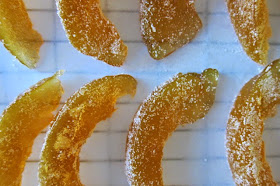 |
| Candied Cedro |
I'm ending this year on a preserving note. Though everyone has their sleeves rolled up and heads filled with Christmas dinner thoughts right now, don't miss the fantastic flow of continental citrus arriving over the next few weeks. Packed with vitamin C, citrus fruit is just what we need at this time of year.
With the Mediterranean citrus harvest well under way, it's time to get candying. Candied citrus peel is so versatile. It can be eaten simply sprinkled with caster sugar, dipped in chocolate, or added to cakes, breads, tarts, and ice-creams. Of course, you can buy candied peel in tubs from the supermarket, but if you're enjoying the gorgeous fresh fruits, don't throw away the peel. If you candy it properly, and keep it in the fridge, it will be good for months. Above all, it tastes far better than the supermarket version.
Despite their association with the Mediterranean, all members of the orange family originated in China and were brought to Europe by Arab traders. The present day citrus groves stretching from India across to Spain mark the path of conquering muslim armies in the sixth and seventh centuries. The first oranges grown were the bitter Citrus aurantium. Too bitter to eat from the tree, they were cultivated for the scent of their blossom, for perfumes, and for distilling into orange blossom water to flavour food. Sweet oranges, Citrus sinensis, arrived in the 17th century.
 |
| Cedro |
In North African countries, sour pickled citrus fruits are favoured and used for flavouring tagines. The Italians like to candy fruits whole. In the hills around Genoa the rare Chinotti grows. The candying process transforms this rather bitter citrus fruit into the most exquisite Christmas treat rarely found outside Liguria.
Marmalade has long been a revered preserve in the UK and most families have their recipe. It's a particularly British taste that only the bitter Seville orange can meet. The peel, for me, has a certain bitter appeal when candied. They too will be arriving very soon but it's time to get candying the citrus fruits that are already here.
 |
| Candied orange and lemon peel |
Candying whole fruit is something I leave to the experts, but preserving the peel is rather easier. Some people like to scrape away the white pith under the skin of the fruit before candying. It's not necessary so long as you boil the skins in fresh water several times to remove the bitterness and you get a much more luscious candied citrus. Just make sure you candy only one type of citrus peel at a time to ensure you retain its specific flavour. I like to candy some in quarters and some in thinner slices, but it's up to you.
Candied Citrus
500g (1lb) citrus peel (pith attached)
600g caster sugar + 60g to sprinkle on the cooked peel
350ml water
Cut the peel into the size, or sizes, you want. Place in a heavy-based pan, cover with water, bring to the boil and cook for 10 minutes. Drain the peel and repeat this process twice more. Dissolve the sugar in the water over a low heat, then bring to the boil. Add the peel, turn the heat down to a slow simmer and cook until the peel is translucent. This will take from 30 minutes for thin slices to 2 hours for thick quarters of cedro.
If you're candying various sizes, use a slotted spoon to remove the citrus peel when translucent and place on greaseproof paper. I like to leave leave the largest pieces in the syrup for 30 minutes after turning off the heat and before placing them on the paper. Spread them out so the pieces don't touch and leave overnight. Next day sprinkle the peel with the reserved caster sugar. the keeping quality of candied peel depends on how moist your finished peel is. You want it soft and yielding yet dried out enough after cooking not be too moist and sticky the next day when you sprinkle it with the 60g of sugar. They'll keep in a plastic container in the fridge for several weeks or even months depending on moisture levels. If it's soft and luscious you'll want to use it but if you do want to store some for longer, then allow some pieces to dry out for longer before sugaring and storing.